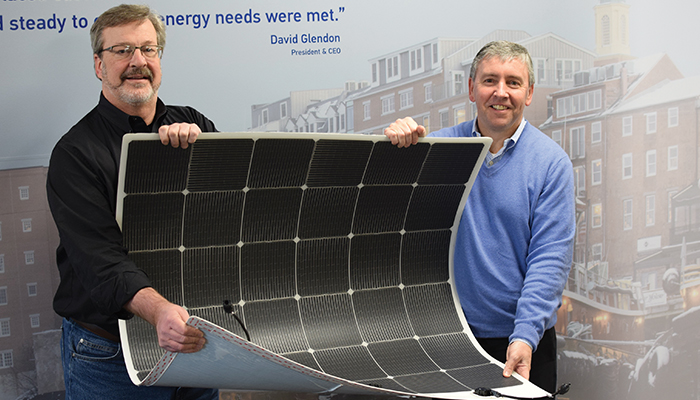All
Petrolectrification

Kevin Maloney, CEO of Picktricity, and David Glendon, CEO and President of Sprague, hold one of the solar panels applied to Sprague’s South Portland, Maine terminal tank. Weighing in at under five pounds for a 4’x4’ section, the panels are closer in size to an all-weather floor mat than to traditional heavy solar panels.
As natural gas’s risk factors — environmental, economic and safety-related — become more apparent with each passing winter, politicians who once touted the fuel as a “bridge” to a renewable energy future now seem eager to make a leap of faith and embrace electrification as the solution for America’s transportation and heating needs, regardless of how viable or realistic that solution actually is at this point in time.
As a result, some diesel, heating oil, gasoline, and propane sellers — many of whom are actively driving the transition to alternative energy with products like biofuels and propane autogas — are beginning to see in electrification the same existential threat posed by natural gas. They argue that just as electric heat pumps are not up to the task of providing safe and reliable heat in cold-weather climates, regional power grids are incapable of simultaneously supporting the massive energy demands of a region’s industrial, commercial, and residential heating and transportation sectors; a sound argument by most calculations.
And yet, some petroleum sellers are beginning to think outside the box — or more specifically, outside the tank — when it comes to electricity and electrification. Here, we look at two well-known energy companies moving to make renewable electricity work for, rather than against, their businesses.
An Industry First
No matter where you stand on the debate over electrification, one thing is certain: the energy industry is evolving quickly, and the desire to improve sustainability is greater than ever.
On February 11, 2019, Sprague Resources LP (NYSE: SRLP) announced that its subsidiary, Sprague Operating Resources LLC (Sprague), and Picktricity LLC had teamed up to respond to that aspiration in a way that will reduce emissions, save money, and help others do the same.
Picktricity, a Massachusetts-based installer of thin-film solar panels, originally approached Sprague to apply adhesive solar panels to one of its tanks in 2017. The thin-film panels, unique in that they can be directly applied to flat surfaces, are significantly more flexible and lighter in weight than traditional panels, which also require the additional weight of racks and bolts for installation.
Sprague, a recognized pioneer in the energy industry, agreed to a pilot program, and quickly saw positive results.
“We put the panels on a typical storage tank to see if we could use our existing assets to generate energy savings while enhancing our sustainability efforts,” said Jay Leduc, Director of Sustainability at Sprague. “With the pilot project generating annual savings, we are excited to roll this out on many more of our tanks, and take advantage of greater savings and possible revenue generation.”
Founded in 1870, Sprague has a long history of evolving to meet customers’ changing energy needs. Sprague was one of the first companies to bring ultra-low sulfur diesel to the Northeast, and among the first BQ9000 certified biodiesel marketers in the United States.
“Sprague’s proven ability to anticipate and stay ahead of market changes aligns exactly with our vision,” said Kevin Maloney, founder and Chief Executive Officer at Picktricity. “They have the deep industry knowledge and relationships, and we have the solar installation expertise with best-in-class thin-film solar technology. We’re excited to collaborate to bring great opportunities for sustainability and electricity cost savings to the energy industry and beyond.”
After realizing the benefits at its own terminal, and recognizing the opportunity to help expand sustainability efforts across the industry, Sprague began partnership talks with Picktricity to expand the use of the technology not only on its own storage tanks, but also to offer the solution to other terminal operators throughout the United States.
“Sprague is pleased to develop a partnership focused on renewable energy,” said David Glendon, President and Chief Executive Officer at Sprague. “The flexible solar panels are an excellent way for us to expand our sustainability efforts while leveraging our existing infrastructure.”
With Sprague’s experience in fuel supply and Picktricity’s expertise in solar installation, the two companies find themselves well positioned to help terminal owners choose locations where the flexible thin-film product will have the greatest impact.
“Many of the options available allow terminal owners to receive power savings and environmental benefits without the requirement of capital investment,” said Glendon. “Throughout our history, we’ve enjoyed success adapting our products and services to the evolving energy needs of our customers. Sustainable energy solutions, whether they are adding biofuels or renewable diesel, supporting wind installations, or providing turnkey solar solutions, simply make sense.”
Buying In
Sprague’s announcement came less than two weeks after the news that a fast-growing Shell subsidiary had acquired a leading electric vehicle charging and energy management software company.
On January 30, Los Angeles-headquartered Greenlots announced it had signed an agreement to become a wholly owned subsidiary of Shell New Energies US LLC, part of Royal Dutch Shell plc. With this deal, Greenlots’ technology and team become the foundation for Shell’s continued expansion of electric mobility solutions in North America. Together, the companies plan to offer software and services that enable large-scale deployment of smart charging infrastructure and integrate efficiently with advanced energy resources like solar, wind and power storage.
“As power and mobility converge, there will be a seismic shift in how people and goods are transported,” predicted Brett Hauser, Chief Executive Officer of Greenlots. “Electrification will enable a more connected, autonomous and personalized experience. Our technology, backed by the resources, scale and reach of Shell, will accelerate this transition to a future mobility ecosystem that is safer, cleaner and more accessible.”
“As our customers’ needs evolve, we will increasingly offer a range of alternative energy sources, supported by digital technologies, to give people choice and the flexibility, wherever they need to go and whatever they drive,” said Mark Gainsborough, Executive Vice President, New Energies for Shell. “This latest investment in meeting the low-carbon energy needs of US drivers today is part of our wider efforts to make a better tomorrow. It is a step towards making EV charging more accessible and more attractive to utilities, businesses and communities.”
With the backing of Shell, Greenlots now looks to intensify its growth efforts and expand its range of mobility services to utilities, cities, automakers, fleets and drivers around the world. To date, the company has deployed projects in 13 countries.
Shell established its New Energies division in 2016. Shell New Energies focuses on two main areas: new transportation fuels, such as advanced biofuels and hydrogen; and power, being involved at almost every stage of the process, from generating electricity, to buying and selling it, to supplying it directly to customers. Shell aims to make electricity a significant part of its business.
Growing Up Fast
The U.S. Energy Information Administration (EIA) expects non-hydroelectric renewable energy resources such as solar to be the fastest growing source of U.S. electricity generation for at least the next two years. EIA forecasts that electricity generation from utility-scale solar generating units will grow by 10% in 2019 and by 17% in 2020.
Solar is the third-largest renewable energy source in the United States power sector, having surpassed biomass in 2017. The U.S. electric power sector plans to add more than 4 GW of new solar capacity in 2019 and almost 6 GW in 2020, a total increase of 32% from the operational capacity at the end of 2018. Because of this increase, solar is forecast to contribute slightly more than 2% of total utility-scale generation in 2020.
In addition to utility-scale solar in the electric power sector, some residences and businesses, like Sprague, have installed small-scale solar photovoltaic systems to supply some of the electricity they consume. EIA forecasts that small-scale solar generating capacity will grow by almost 9 GW during the next two years, an increase of 44%.
Nevertheless, even with the growth from renewable energy sources, EIA confirms that fossil fuels will still provide most of the electricity generated in the United States.
Related Posts
 What’s Next in Boiler Technology
What’s Next in Boiler Technology
Posted on June 25, 2025
 Data Delivers!
Data Delivers!
Posted on April 28, 2025
 Harnessing Payment Data to Increase Profitability
Harnessing Payment Data to Increase Profitability
Posted on March 10, 2025
 DeepSeek Is Our AI Wake-Up Call
DeepSeek Is Our AI Wake-Up Call
Posted on March 10, 2025
Enter your email to receive important news and article updates.
